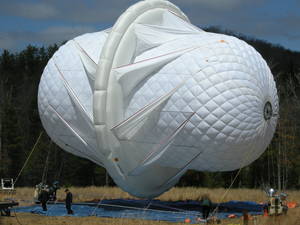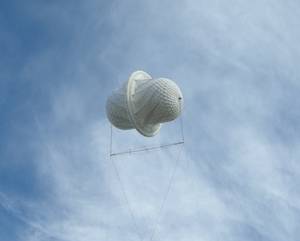Lets Go Fly a Turbine...
Interview with
Chris - Capturing the wind at ground level is pretty effective, but not everyone is as lucky as those souls down in Antarctica with those horrendously strong and very cold winds. Winds are much faster though higher up in the atmosphere. But how do you get a wind turbine up there to make use of them? Well, Pierre Rivard is a researcher who works for Magenn Power, they're a company who've developed an inflatable answer to the problem. Hello, Pierre.
Pierre - Hello. Good to be here.
Chris - Welcome to The Naked Scientists. Please tell us first of all, how much more powerful are the winds that you can get access to if you can get a bit further up there?
Pierre - Well Chris, the wind power is a cubic function of speed. Meaning by that, that if you double the wind speed, you have eight times the wind power available to you, and in most locations around the world, going as high as a thousand feet above ground would double the wind speed accessible to wind power.
Chris - So in other words, you could turn your average wind turbine from pumping out, say for a big one, 1500-kilowatt probably into at least a megawatt?
Pierre - Yes, but more importantly, the percentage of nameplate capacity that would be gainfully employed could as much as double. In other words, a typical wind turbine would be productive only at 20 percent of its nameplate capacity, but up there, it could be employed to as much as 50 percent of its nameplate capacity which reduces the stranded asset element of wind power.
Chris - And this is what you're saying with respect to the fact that the wind up there, higher up, blows regularly, reliably, and most of the time whereas down on earth, unfortunately it doesn't.
Pierre - Yes, absolutely. Professor Ken Caldera from Stanford University with his colleague, Dr. Christina Archer characterised this energy as the most concentrated source of global renewable energy on Earth. They believe that there's enough energy up there to power the needs of civilization a hundred times over, and it's only a matter of time before we learn ways to harness this energy.
Chris - Speaking of which, you've got one possible solution. Talk us through it. 
Pierre - Okay. Well, we've demonstrated what we believe to be the world's first airborne wind turbine. We were followed for a year by the Discovery Channel in 2007 and demonstrated 1 kilowatt of airborne production of electricity, and we brought it down through a tether to ground level. We're now engaged in scaling up this 1 kilowatt prototype to 30 kilowatts which we hope to achieve by mid-year of this year and rapidly scale up to the 100-kilowatt mark shortly thereafter.
Chris - Okay, so the basic premise is that you have a system that gets a generator way up there high in the atmosphere to a thousand feet or something?
Pierre - Yes. We're starting at a thousand feet because the length of the tether is less daunting in terms of lifting its own weight. Our design is very unique. We use kind of a paddle wheel, kind of a wind turbine which we elevate to a thousand feet and again, because we have eight times the power accessible to us than what we would have at ground level, the actual energy conversion efficiency is not quite as important as the fact that we have eight times the power available to us as what we would have at the ground level.
Chris - So this looks like a giant suspended water wheel, I guess is one way of thinking about, isn't it? So you float that up using something buoyant, helium presumably, to get it up there.
 Pierre - That's correct. We could use other buoyant gases such as hydrogen or natural gas, or some of the welding gases, but we use helium right now because it's an inert gas, and it's the best way to start. Ultimately, we could use hydrogen which could be renewably produced using water and electrolysis in the developing world.
Pierre - That's correct. We could use other buoyant gases such as hydrogen or natural gas, or some of the welding gases, but we use helium right now because it's an inert gas, and it's the best way to start. Ultimately, we could use hydrogen which could be renewably produced using water and electrolysis in the developing world.
Chris - So this takes the generating system up to a thousand feet or so, where it sees the wind, and this causes it to rotate. So presumably, you have a core spindle which is stationary and the body of the generator rotates around that spindle, and that's how you get the power out.
Pierre - Yes, that' correct. We have some proprietary ways of doing this. Some of the aerodynamic challenges which were documented in the Discovery Channel program, identify that there's a challenge in flying a paddle wheel broad-wise to the wind, but we managed to solve this issue, and we've also moved away from a central generator on the axle to a more innovative approach which we find is to be lighter and would also leverage on automotive parts from the electric car industry to reduce cost, but also to enhance the commercialisation of the product.
Chris - And you recover the electricity down the line that's supporting, or tethering, the machine up in the air.
Pierre - Yes. The tethering is very important. We use a plastic by the name of Vectron. For some of the listeners, they may know Vectron as a plastic that has more strength than steel on a per weight basis. And within the Vectron tether, we had some embedded copper wires that would bring down the electricity to the ground level and we also had some data links within the tether. So it's a highly engineered tether at the present time and this is no longer a technological issue for us.
Chris - Presumably, you could use this where you wanted sustainable, reliable power. But in say, remote places, so if you were running a station in the middle of a desert or something, rather than have to ship and lug of diesel out there or to have a generator, you could put one of your systems up in the air, above where you're working, and just bring the power down to the plant.
Pierre - Yes, indeed Chris. This is one of the typical, crucial applications. Our tagline is wind power anywhere and really, when you think about the 1.6 billion people without electricity on Earth, when you use, let's say solar, you have a renewable source that is intermittent and without storage it's difficult to harness around the clock. However, our device, because the winds are more constant and stronger at altitude, multiplies the number of sites where wind becomes economical and makes sense, and certainly to bring renewable energy to the rural electrification of China and India, we believe we have a great solution here.
Chris - And just to finish off, the one thing that's going to recur to many people is, I hope there's no airports nearby.
Pierre - Yes. We have to abide by some regulations if we are within a certain radius of an airport. We obviously would not get a permit to fly. We need to provide some light markers every 50 feet along the tether, and our device also has a transponder onboard the device, which means, in the unlikely events that it becomes unattached, then a local radar could track it as it travels because of the transponder on board. So everything is done according to regulations and it hasn't been an issue in the demonstrations we've done to-date.
Chris - Brilliant. Well we must leave it there Pierre, but thank you for joining us. That was Pierre Rivard who worksfor Magenn Power, based over in a Canadian company, but also right across America. As long as you live in an area where there are no aeroplanes, then they could have the solution for you in the form of a way of generating power using an inflatable turbine!
- Previous Wind Power in the Antarctic
- Next 10th Naked Anniversary!










Comments
Add a comment